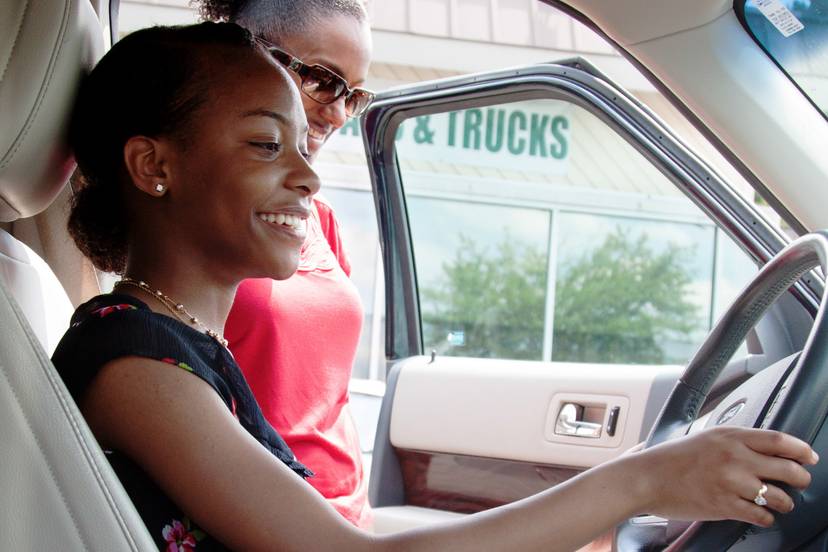
The subcompact SUV class has stretched the definition of sport utility vehicle more than most. Some entrants, like the C-HR, offer a carlike ride height and skip all-wheel drive (it’s front-drive only). The Kona at least offers all-wheel drive, making it easier to think of it as an SUV, but its low ride height and overall shape call to mind a more traditional small hatchback.
Our test car was a front-wheel-drive Kona SEL with a $22,405 as-tested price ($980 destination charge included). See how the Kona’s specs compare with the Trax, HR-V and C-HR.
How It Drives
The Kona’s driving experience impresses in many ways. It’s easy to maneuver in the city and secure at highway speeds. The transmission is quick to react when you need more power, and it shifts smoothly. It feels stable in quick corners, with limited body roll. Combine that with its responsive steering, and the Kona is surprisingly fun to drive.
The thing that reminds you of the Kona’s entry-level position in Hyundai’s SUV lineup, however, is its suspension tuning. It has a firm ride, like the C-HR and Ford EcoSport, and it lacks refinement when you hit bumps and ruts.
SE and SEL Konas are powered by a 2.0-liter four-cylinder engine that makes 147 horsepower. Limited and Ultimate trim levels get a turbo four-cylinder rated at 175 hp. The 2.0-liter engine revs smoothly and feels well-matched to the standard six-speed automatic transmission. There’s some gas-pedal lag when accelerating from a standstill but selecting Sport mode wakes the Kona up; gas-pedal response is notably better, upshifts are delayed and the SUV feels a lot peppier as a result.
Acceleration is acceptable in the city, but the engine doesn’t have much reserve power at highway speeds; even though the automatic transmission is quick to kick down, passing power is modest.
Regardless of the engine, front-wheel-drive Konas get an EPA-estimated 30 mpg in combined driving, while all-wheel-drive versions are rated 27 mpg combined. Looking at front-drive competitors, the Kona’s estimated gas mileage tops the Trax (28 mpg) and C-HR (29 mpg) but trails the automatic-equipped HR-V (31 mpg).
The Inside
After taking in the Kona’s daring exterior styling, the interior may be something of a letdown for shoppers. The cabin is very traditional, for one, and it uses relatively basic materials. The headliner is cardboard-like, and hard plastic is used extensively — from the door panels and dashboard to the center console. It’s of the nicer, low-gloss variety, and some of it has unique patterns rather than ordinary graining, but since you touch it so often — whether resting your arm on the door or your knee against the center console — it’s a frequent reminder of the Kona’s entry-level status. Then there are the three dials for the manual air conditioning system that already feel 10 years old. Basic interior quality isn’t uncommon in this class, but some competitors, like the HR-V and C-HR, do it better.
Other elements, though, impress. The cloth front seats are comfortable and feature an attractive houndstooth pattern. Even though seat comfort is good, I did want the height-adjustable driver’s seat to go higher; even with the seat at its highest position I still felt like I was sitting too low.
The multimedia system is another highlight. It has a standard touchscreen with intuitive menus, as well as supplementary steering-wheel controls. Apple CarPlay and Android Auto smartphone connectivity are standard, and CarPlay worked well with an iPhone 8; the Maps app responded quickly, it was easy to switch between CarPlay and Hyundai’s multimedia experience, and the screen looked great.
One minor multimedia downside, though, is reception quality for the available HD Radio; the HD signal kept going in and out during my testing — much more so than in other cars. It got annoying after a while, so I turned it off and just listened to the regular FM broadcast.
There’s also more backseat room than you might expect; taller adults sit comfortably with enough legroom and headroom. There’s not much in the way of extra space, but the Kona is space-efficient enough to carry four adults.
Cargo and Storage
The Kona’s cargo area measures 19.2 cubic feet. When you need more space, the 60/40-split backseat folds flat with the cargo floor for 45.8 cubic feet of maximum cargo room. A cargo cover and underfloor organizer for odds and ends are standard. Storage areas include a small console bin and a spot for a smartphone near the standard USB port.
Safety
In Insurance Institute for Highway Safety tests, the Kona received the highest rating of good (out of a possible good, acceptable, marginal or poor) in all crashworthiness tests. Additionally, the SUV’s optional automatic emergency braking system is rated superior — the best possible ranking. Poor headlight performance and a marginal rating for Latch connector usability (something we also observed in our Car Seat Check) were its only shortcomings in IIHS tests.
To get the most advanced active safety features you must upgrade to an SEL or Ultimate trim; a $1,500 Tech Package for the SEL adds forward automatic emergency braking with pedestrian detection, lane-keeping assist and a driver-drowsiness monitor. (All these safety features are standard on the top-of-the-line Ultimate model.)
Should I Buy It?
If you want a small SUV that delivers decent utility and passenger space, is relatively fun to drive, includes a lot of standard features and looks like little else on the road (especially now that the Jeep Cherokee has different styling), the Kona is worth a look. The basic interior and at-times-harsh ride may be deal-breakers for some, but those are the biggest shortcomings in an otherwise-compelling package.
Cars.com’s Editorial department is your source for automotive news and reviews. In line with Cars.com’s long-standing ethics policy, editors and reviewers don’t accept gifts or free trips from automakers. The Editorial department is independent of Cars.com’s advertising, sales and sponsored content departments.

















































